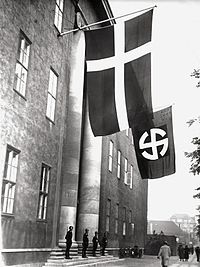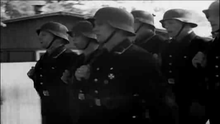
Ernst Kaltenbrunner was a high-ranking Austrian SS official during the Nazi era and a major perpetrator of the Holocaust. After the assassination of Reinhard Heydrich in 1942, and a brief period under Heinrich Himmler, Kaltenbrunner was the third Chief of the Reich Security Main Office (RSHA), which included the offices of Gestapo, Kripo and SD, from January 1943 until the end of World War II in Europe.

Heinrich Luitpold Himmler was a German politician who was the 4th Reichsführer of the Schutzstaffel, a leading member of the Nazi Party of Germany, and one of the most powerful men in Nazi Germany, primarily known for being a main architect of the Holocaust.

Nazi Germany, officially known as the German Reich and later the Greater German Reich, is a term used to describe the German state between 1933 and 1945, when Adolf Hitler and the Nazi Party controlled the country, transforming it into a totalitarian dictatorship. The Third Reich, meaning "Third Realm" or "Third Empire", referred to the Nazi claim that Nazi Germany was the successor to the earlier Holy Roman Empire (800–1806) and German Empire (1871–1918). The Third Reich, which the Nazis referred to as the Thousand-Year Reich, ended in May 1945, after only 12 years, when the Allies defeated Germany and entered the capital, Berlin, ending World War II in Europe.

The Schutzstaffel was a major paramilitary organisation under Adolf Hitler and the Nazi Party in Nazi Germany, and later throughout German-occupied Europe during World War II.
Sicherheitsdienst, full title Sicherheitsdienst des Reichsführers-SS, or SD, was the intelligence agency of the SS and the Nazi Party in Nazi Germany. Established in 1931, the SD was the first Nazi intelligence organization and the Gestapo was considered its sister organization through the integration of SS members and operational procedures. The SD was administered as an independent SS office between 1933 and 1939. That year, the SD was transferred over to the Reich Security Main Office, as one of its seven departments. Its first director, Reinhard Heydrich, intended for the SD to bring every single individual within the Third Reich's reach under "continuous supervision".
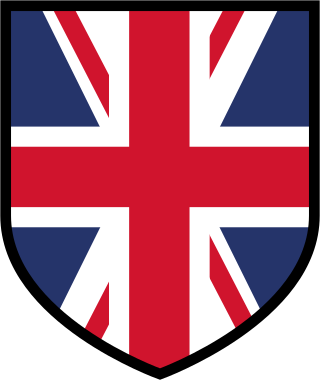
The British Free Corps was a unit of the Waffen-SS of Nazi Germany during World War II, made up of British and Dominion prisoners of war who had been recruited by Germany. The unit was originally known as the Legion of St George. Research by British historian Adrian Weale has identified 54 men who belonged to this unit at one time or another, some for only a few days. At no time did it reach more than 27 men in strength.
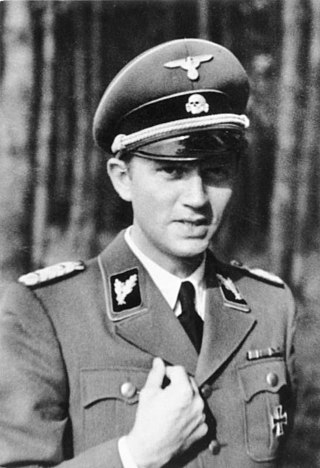
Walter Friedrich Schellenberg was a German SS functionary during the Nazi era. He rose through the ranks of the SS, becoming one of the highest ranking men in the Sicherheitsdienst (SD) and eventually assumed the position as head of foreign intelligence for Nazi Germany following the abolition of the Abwehr in 1944.

The Waffen Grenadier Brigade of the SS Charlemagne was a Waffen-SS unit formed in September 1944 from French collaborationists, many of whom were already serving in various other German units.

Gottlob Christian Berger was a senior German Nazi official who held the rank of SS-Obergruppenführer und General der Waffen-SS and was the chief of the SS Main Office responsible for Schutzstaffel (SS) recruiting during World War II. At the post-war Nuremberg trials, the Waffen-SS – within which Berger was a senior officer – was declared to be a criminal organisation due to its major involvement in war crimes and crimes against humanity. Berger was convicted as a war criminal and spent six and a half years in prison.

The Reich Security Main Office was an organization under Heinrich Himmler in his dual capacity as Chef der Deutschen Polizei and Reichsführer-SS, the head of the Nazi Party's Schutzstaffel (SS). The organization's stated duty was to fight all "enemies of the Reich" inside and outside the borders of Nazi Germany.
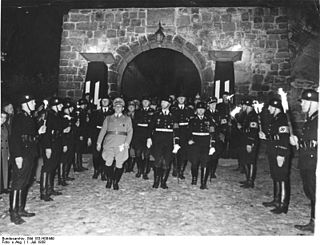
The Allgemeine SS was a major branch of the Schutzstaffel (SS) paramilitary forces of Nazi Germany; it was managed by the SS Main Office (SS-Hauptamt). The Allgemeine SS was officially established in the autumn of 1934 to distinguish its members from the SS-Verfügungstruppe, which later became the Waffen-SS, and the SS-Totenkopfverbände, which were in charge of the Nazi concentration camps and extermination camps. SS formations committed many war crimes against civilians and allied servicemen.

Non-Germans in the German armed forces during World War II were volunteers, conscripts and those otherwise induced to join who served in Nazi Germany's armed forces during World War II. In German war-time propaganda those who volunteered for service were referred to as Freiwillige ("volunteers"). At the same time, many non-Germans in the German armed forces were conscripts or recruited from prisoner-of-war camps.

Karl Rudolf Werner Best was a German jurist, police chief, SS-Obergruppenführer, Nazi Party leader, and theoretician from Darmstadt. He was the first chief of Department 1 of the Gestapo, Nazi Germany's secret police, and initiated a registry of all Jews in Germany. As a deputy of SS-Obergruppenführer Reinhard Heydrich, he organized the World War II SS-Einsatzgruppen, paramilitary death squads that carried out mass-murder in Nazi-occupied territories.

Political decorations of the Nazi Party were medals and awards issued by the National Socialist German Workers Party (NSDAP) between 1920 and 1945. Political awards were authorised for wear on any paramilitary uniform of Nazi Germany, as well as civilian attire, but were generally discouraged on Wehrmacht military uniforms. The Waffen-SS freely wore both political awards and military decorations on their uniforms.

The SS Main Economic and Administrative Office was a Nazi organization responsible for managing the finances, supply systems and business projects of the Allgemeine-SS. It also ran the concentration camps and was instrumental in the implementation of the Final Solution through such subsidiary offices as the Concentration Camps Inspectorate and SS camp guards.
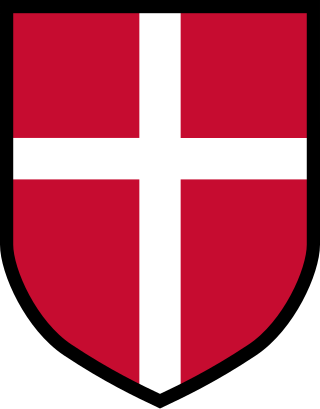
Free Corps Denmark was a unit of the Waffen-SS during World War II consisting of collaborationist volunteers from Denmark. It was established following an initiative by the National Socialist Workers' Party of Denmark (DNSAP) in the immediate aftermath of the German invasion of the Soviet Union in June 1941 and subsequently endorsed by Denmark's government which authorised officers of the Royal Danish Army to enlist in the unit. It participated in fighting on the Eastern Front and was disbanded in 1943. During the course of the war, approximately 6,000 Danes joined the corps, including 77 officers of the Royal Danish Army.
Heinz Höhne was a German journalist and author, who specialized in Third Reich military and West German Cold War foreign intelligence history.

During World War II, the Waffen-SS recruited significant numbers of non-Germans, both as volunteers and conscripts. In total some 500,000 non-Germans and ethnic Germans from outside Germany, mostly from German-occupied Europe, were recruited between 1940 and 1945. The units were under the control of the SS Führungshauptamt beneath Reichsführer-SS Heinrich Himmler. Upon mobilisation, the units' tactical control was given to the Oberkommando der Wehrmacht.

The ideology of the Schutzstaffel, a paramilitary force and an instrument of terror of the Nazi Party in Nazi Germany, emphasized a racist vision of "racial purity", primarily based on antisemitism and loyalty to Adolf Hitler and Nazi Germany.
The SS Education Office (SS-Schulungsamt) was one of the Nazi organizations responsible for the ideological indoctrination of members of the SS. The office operated initially under the jurisdiction of the Reich Race and Settlement Office (RuSHA) but was later subordinated to the SS Main Office (SS-Hauptamt).

